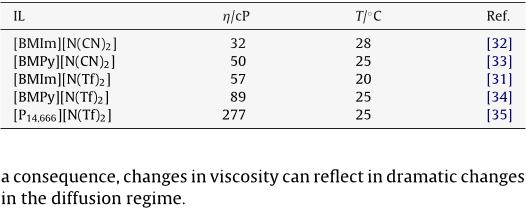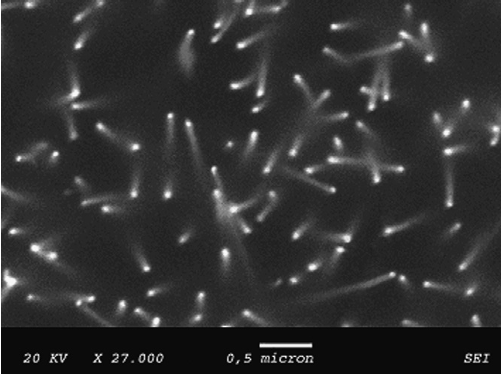Abstract: The electrochemical properties of the room temperature ionic liquids 1-butyl-3-methylimidazolium tetrafluoroborate (BMIM+BF4−), 1-butyl-3-methylimidazolium hexafluorophosphate (BMIM+PF6−) and 1-methyl-3-[2,6-(S)-dimethylocten-2-yl]imidazolium
tetrafluoroborate (MDIM+BF4−) as solvents have been studied using micro-samples, with a volume of 10 μL, of the ionic liquids under vacuum conditions and under conditions with controlled gas and moisture supplies. The impact of water—absorbed into the ionic liquid in a controlled manner from the gas phase—on
the voltammetry of dissolved redox systems and on the accessible potential window of the ionic liquids was investigated. The diffusion coefficients for three representative redox systems, the oxidation of neutral N,N,N′,N′-tetramethyl-p-phenylenediamine
(TMPD), the reduction of cationic methyl viologen (MV2+) and reduction of anionic hexacyanoferrate(III), Fe(CN)63−, have been determined as a function of the water content of the ionic liquids. Water
is shown to have a much more dramatic acceleration effect on the diffusion of the ionic compounds compared to its effect on neutral species in ionic liquids. A model based on nanoscale structural features of wet ionic liquid materials
is proposed. The novel methodology, which employs redox-active compounds dissolved or partitioned in microdroplets of ionic liquid, uses conditions suitable for the study of ionic liquids for applications in electrochemical gas phase reactors and gas sensor
systems.
![Fig. 5. Cyclic voltammograms recorded at different scan rates at a NEE (geometric area 0.07 cm2; active area 0.004 cm2): (A) 20mM Fc [BMPy][N(Tf)2]; (B) 5mM Fc in [BMIm][N(Tf)2]; (C) 50mM Fc [P14,666][N(Tf)2]. Scan rates: full line 5mV/s; dashed line 50mVs−1; dotted line 500mV/s.](/figures/fig-5-cyclic-voltammograms-recorded-at-different-scan-rates-186vzx3c.png)
![Fig. 6. Dependence of the I/Imax ratio on the scan rate (A) and on the square root of the scan rate (B) for ferrocene oxidation at a NEE in: ( ) [BMPy][N(Tf)2]; (©) [BMIm][N(Tf)2]; ( ) [P14,666][N(Tf)2].](/figures/fig-6-dependence-of-the-i-imax-ratio-on-the-scan-rate-a-and-2eggn6ay.png)

![Fig. 7. (A) Cyclic voltammograms of 1mM FcCOO− in [BMPy][N(Tf2)] recorded a l (](/figures/fig-7-a-cyclic-voltammograms-of-1mm-fccoo-in-bmpy-n-tf2-3kajg4vn.png)

![Fig. 2. (A) Cyclic voltammograms of 1mM Fc in [BMIm][N(CN)2] recorded at GCE (geometric area 0.19 cm2) at different scan rates: 20, 50, 100, 200, 500, 1000mVs−1; peak currents scale with the scan rate. (B) Dependence of the anodic peak current on the square root of the scan rate.](/figures/fig-2-a-cyclic-voltammograms-of-1mm-fc-in-bmim-n-cn-2-19dawvbt.png)

![Fig. 4. Cyclic voltammograms of 1mM Fc in [BMIm][N(CN)2] recorded at an Au-macro electrode at different scan rates: 50, 100, 200 and 500mVs−1; other parameters as in Fig. 3.](/figures/fig-4-cyclic-voltammograms-of-1mm-fc-in-bmim-n-cn-2-recorded-vavr4b8x.png)
![Fig. 3. (A) Cyclic voltammograms of 1mM FcCOOH in [BMIm][N(CN)2] recorded at an Au-macro electrode (geometric area 0.07 cm2), at different scan rates: 10, 20, 50, 100, 200, 400, 800 and 1000mVs−1; peak currents scale with the scan rate. (B) Dependence of the anodic peak current on the scan rate.](/figures/fig-3-a-cyclic-voltammograms-of-1mm-fccooh-in-bmim-n-cn-2-3hvfscoj.png)